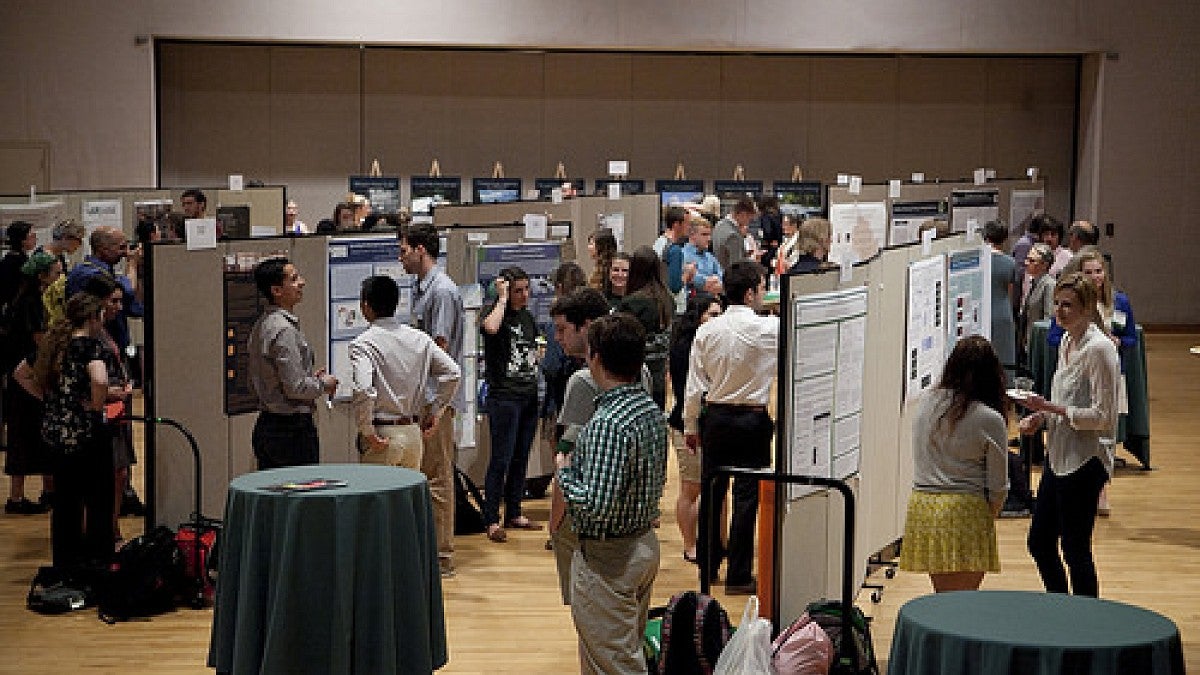As the University of Oregon’s mission statement declares, “We strive for excellence in teaching, research, artistic expression, and the generation, dissemination, preservation, and application of knowledge.”
In the spirit of that research mission, almost 200 UO undergraduate students will present their extensive research projects at the fifth annual Undergraduate Symposium on Thursday, May 14. The event is free and open to everyone; many students invite their classmates, friends and family, while the university has reached out to local schools to provide young students a glimpse into the college academic experience.
The symposium will be held in the Erb Memorial Union ballroom and adjacent rooms from 11 a.m. to 7 p.m. Nearly 130 research projects — completed by students from 46 disciplines in seven different colleges within the UO — will be on display.
“It’s our responsibility as a research institution to show that respect to undergraduates, to honor their work and recognize it in a public space,” said Kevin Hatfield, a UO professor and director of academic, residential and research initiatives. “We want to acknowledge students who have done more than just accumulate courses they’ve taken.”
Like a typical academic conference, the symposium will include professional poster presentations and oral expositions by students, individually or in groups, from 5 p.m. to 7 p.m. that evening. However, live demonstrations and exhibitions are not uncommon either.
Alexander Bean, a student studying music composition and organ performance, will be performing his project, “On the Nature of Space and Breath.” His research has centered on what Western vocal traditions lack: physical speech sounds with no semantic meaning — in other words, songs that don’t use lyrics or text. After explaining his research, Bean will perform the music in the 10-12 minutes allotted for each oral/live presentation.
Overall, the conference will feature 55 science projects, 45 social science projects, 19 research projects focused on the humanities and 10 fine art presentations. Anthropology students are slated to have the most numerous presentations, with 15.
For undergrad anthropologist Daniel Goodkin-Gold, the decision to participate in the symposium was not hard. He’s presented his research on captive female bonobo interaction before — at the American Association of Physical Anthropologists annual conference. With his poster and presentation already nailed down, he decided to join the symposium’s lineup to let more people know about the research he has been conducting.
“It allows my friends, co-workers and peers who are curious about the work I have been doing the opportunity to actually see it, engage with it and learn about it,” Goodkin-Gold said. “I understand that not everyone is passionate about primate behavior, but I hope they enjoy themselves and learn something in the process.”
Goodkin-Gold’s research, and his professional experience presenting it, embodies some of the main objectives of the symposium: to help prepare participants for future academic or professional conferences and to provide them with concrete examples of their work for when they apply for positions in their fields of study.
These practical benefits didn’t immediately persuade English major Samantha Elwood, however, who needed a bit of a nudge from her professor before she decided to showcase a research paper she’d written for a class on Native American images in literature and film.
Ultimately, Elwood decided to go for it. She will present her research, along with a slideshow, on the problematic relationships between white male protagonists and native populations in James Cameron’s film, “Avatar,” and James Fenimore Cooper’s novel (and eventually Michael Mann’s film), “The Last of the Mohicans.”
“I have found that I’m really passionate about this subject and excited to bring what knowledge I have learned about the Native American image in film to my audience,” Elwood said. “I hope to encourage people to question this history and the naturalization of these extremely damaging images of Native Americans.”
This year, the UO Museum of Natural and Cultural History will honor one group’s project with the museum's inaugural Stewardship Award. The award, created by the museum’s student ambassadors and open to all students participating in the symposium, acknowledges compelling research that promotes environmental conservation and cultural preservation.
The award “is a way to recognize student research that inspires stewardship of our natural and cultural heritage," said Steve Dobrinich, the museum’s campus outreach coordinator.
A judging panel will analyze projects throughout the day on criteria such as originality, aesthetics, organization and presentation of scientific data. After the judges tally up their scores for each project, the winner will be announced in the evening.
The Undergraduate Symposium is sponsored by the Division of Undergraduate Studies, Center for Multicultural Academic Excellence, University Housing, Robert D. Clark Honors College, UO Libraries, Office of Equity and Inclusion and Division of Student Affairs.
— By Nathaniel Brown, Public Affairs Communications


